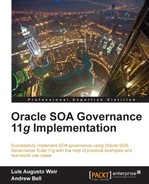The results of the SOA Maturity Assessment mentioned in the previous section were as shown in the following diagram:

The consultancy conducting the maturity assessment identified a number of key challenges as follows:
- The IT department has grown immaturely while trying to constantly react to the demands placed on it by strong retail sales. Consequently, there has been a lack of overall architecture and governance, with IT developments being very tactical in nature. Each business unit within Weir & Bell Telecom has commissioned and developed its own IT systems with little regard for what had already been developed previously.
- Partly due to the lack of architecture and visibility over existing assets, many IT projects have been delivered late and there has been little reuse of existing assets. This has resulted in a poor perception of IT by key business stakeholders.
- Development teams have had little guidance; immature processes and an ill-defined software development lifecycle have resulted in estimates for development being at best optimistic and at worst poorly thought through. This has caused severe problems to the business as IT systems are continually developed late despite best intentions and lots of overtime. Poor estimation models and lack of architecture were identified as key contributors to poor planning, execution, and dependency management.
- SOA has not lived up to expectations with duplicate services being developed on a per-project basis with virtually no reuse of existing assets. This was attributed to the distinct lack of overall governance.
- In occasions, services were being overused, meaning used above the maximum throughput for which the service was designed to support. This resulted in performance penalties in the SOA infrastructure and therefore damaging the user experience.
The assessment concluded that, in order to bring the current maturity level of 1.3 to the required level of 3.8, strong architecture and a new governance framework were required. This would result in other dependent disciplines being intrinsically matured (such as project management and support). The following diagram illustrates the identified health status of the different areas of Governance when compared to a Reference Governance Framework (such as the one described in Chapter 1, SOA Governance):

Furthermore, the outcome of the assessment suggested that, because of a lack of overall strategy and almost nonexistent design-time and runtime governance, SOA initiatives had failed to deliver any measurable business benefits.
